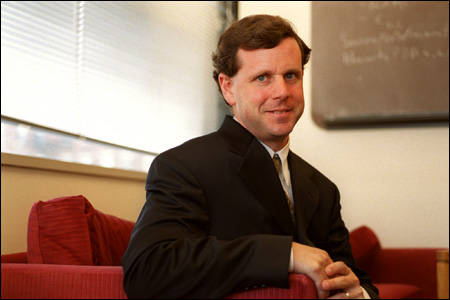Cutler and colleagues say U.S. health care cost-effective
Rising health expenses are a good value, researchers say

Despite dramatic increases in health expenses since 1960, the return on medical spending is high, according to a new study by researchers at Harvard University and the University of Michigan. Studying health and spending trends from 1960 to 2000, the researchers concluded that health care in America has been cost-effective on the whole, although ballooning costs for the elderly are a cause for concern.
In an article published in the Aug. 31 New England Journal of Medicine, David M. Cutler, the Otto Eckstein Professor of Applied Economics in Harvard’s Faculty of Arts and Sciences, and Allison B. Rosen and Sandeep Vijan of the University of Michigan Health System compared average per capita spending and life expectancy of four different age groups from 1960 to 2000, analyzing increases in medical expenses versus improvements in health.
“The rising cost of health care has been the source of a lot of saber-rattling in the media and the public square, without anyone seriously analyzing and discussing the benefits gained,” says Cutler. “But the dramatic increase in life expectancy that we’ve seen over the last decades shows that rising medical costs have been largely justified.”
Conservatively adjusting for nonmedical factors in longevity such as lower smoking prevalence and reduced death rates from accidents, suicide, and homicide, the researchers attributed 50 percent of the increase in life expectancy since 1960 to improved health care.
Following this methodology, Cutler and colleagues estimated that from birth, the increased life expectancy since 1960 (approximately seven years, from 69.90 to 76.87 years) has cost $19,900 per added year of life. Of the portion of this longevity gain attributed to improvements in health care, the researchers estimated that some 70 percent was due to reductions in deaths from cardiovascular disease, while reductions in infant mortality accounted for 19 percent.
Comparing this $19,900 against the value of a year of life as defined by insurance companies and medical decision makers – a figure that ranges from $50,000 to $200,000, according to different statistical estimates – Cutler and colleagues judged the increase in medical costs to be a good value. The researchers write, “The increased spending has, on average, been worth it.”
By contrast, persons ages 65 and older have increased their longevity by just 3.5 years since 1960, with a cost of $84,700 for each year of added life.
“The foremost cause of concern posed by rising medical costs is the tremendous strain coming from increased costs for the elderly,” Cutler says. “The cost per year of life for seniors is three times higher today than it was in the 1970s.”
While Cutler, Rosen, and Vijan indicate that rising costs could lead to diminishing returns as life expectancy reaches a ceiling, the researchers say greatly increased quality of life for the elderly – an important factor not considered in the current study – mitigates in favor of current levels of health care spending among the elderly.
Cutler, Rosen, and Vijan’s work was funded by the National Institute on Aging and the Lasker Foundation.




